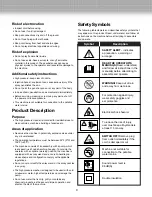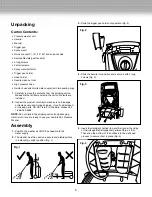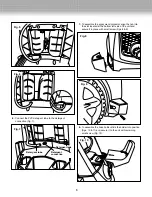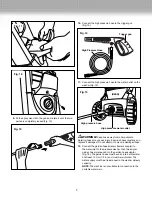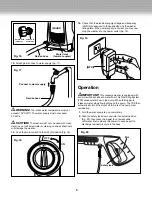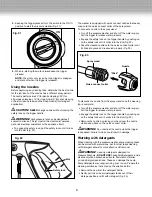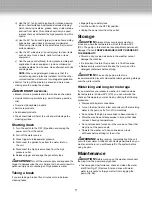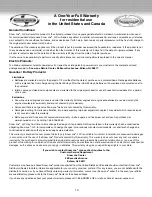
10
• Insert the suction tube with filter into the tank and cap the
tank closed. Push the tanks back into their storage position
on the unit.
• Turn the detergent dial to the center (O) (Fig. 25).
• Install the soap nozzle (black) on the spray wand (Fig. 26).
m
CAUTION!
Always test detergent in an inconspicuous
area before use.
• Turn on the pressure washer. Pull the trigger to operate the
unit. The liquid detergent will automatically mix with water
and be discharged through the nozzle.
• Turn the detergent dial to adjust the suction volume of the
detergent solution (Fig. 25).
• Apply detergent from the bottom to the top of the DRY
surface to be cleaned.
NOTE:
Wetting the surface first is not recommended as it
dilutes the detergent and reduces its cleaning ability.
• Allow the detergent to remain on the surface for a short
time before rinsing. Do not allow the detergent to dry on the
surface.
m
CAUTION!
Damage may occur to painted surfaces if
the detergent is allowed to dry on the surface. Wash and rinse
a small section at a time. Avoid working on hot surfaces or in
direct sunlight.
• When you have finished using the detergent injection
system, remove the detergent suction tube from the
detergent bottle and insert it into 5 L (1 gallon) of fresh
water. Siphon water at low-pressure for one minute so that
all the detergent is flushed through the system. Remove the
detergent bottle and rinse it until it is thoroughly cleaned.
Rinsing with pressure washer
m
CAUTION!
Failure to follow these cleaning instructions
will cause the injection system to become clogged and
inoperable.
• Turn off the pressure washer and shut off the water supply.
• Pull the trigger to release water pressure.
• Engage the safety lock on the trigger handle by pushing up
on the safety lock until it clicks into the slot (Fig. 22).
• Remove the nozzle by placing your hand over the nozzle
while pulling back on the quick-connect collar.
• Select the right nozzle for the job (Fig. 26):
i) A 0º straight pencil point nozzle (orange) is a thin
extremely powerful nozzle used to cut heavy deposits
in a small, concentrated area. It is ideal for dissolving
stubborn substances, like tar and grease spots on
concrete or caked mud from equipment. Use this
nozzle to clean hard-to-reach areas including the
facades of 2-story buildings or the undersides of lawn
mowers/tractors.
NOTE:
Care should be used to avoid gouging wood or
damaging fragile surfaces.
Fig. 24
Detergent tank
Fig. 25
Detergent selection dial
15º
SOA
P
25º
40º
0º
Fig. 26



